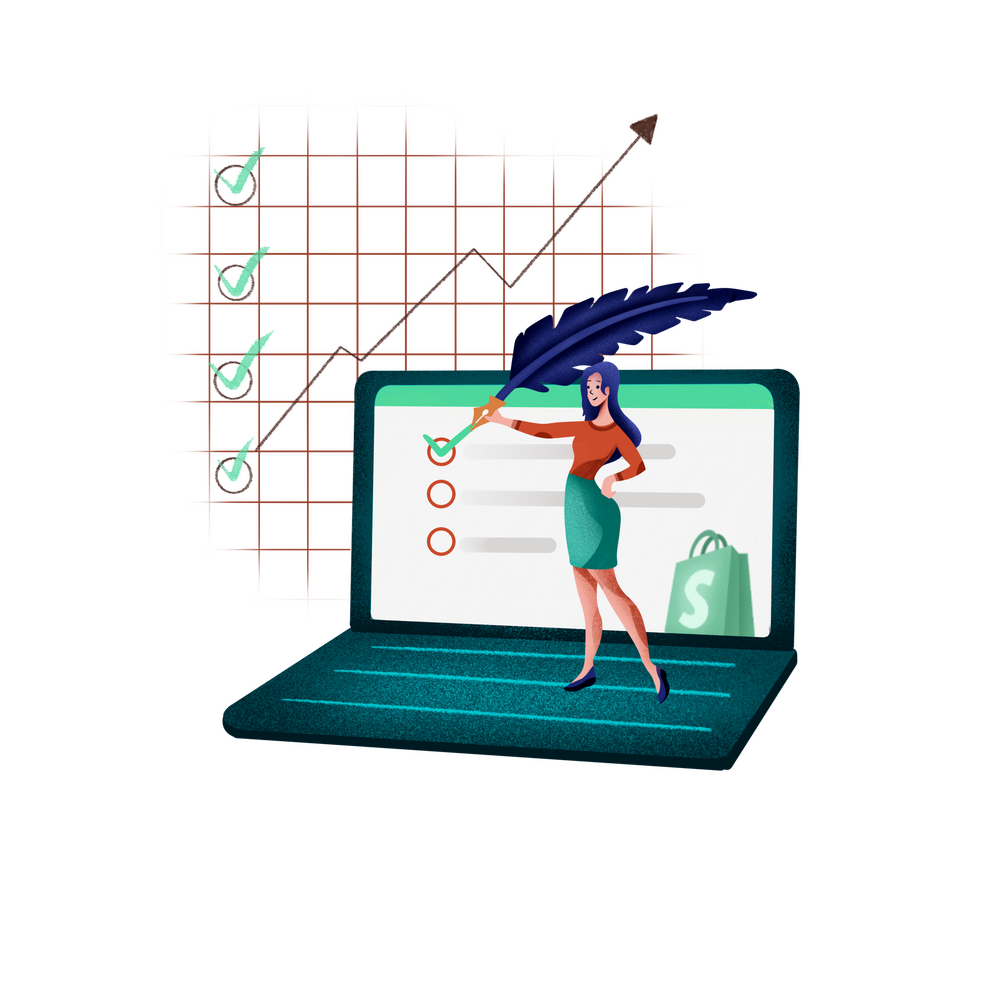The short answer? The average success rate of eCommerce stores is 10%.
But there’s a helluva lot more to becoming a successful Shopify store owner than just knowing the stats. Get comfy; we’ll tell you all about it.
Is It Easy to Set Up a Shopify Store?
Well, yes, but that may be part of the problem. The abysmal success rate of online retailers can perhaps be attributed to the fact that anyone with an ok product and a few hundred dollars can set up shop on the Internet.
Starting an eCommerce store, particularly on Shopify, can be as easy as:
- Registering your domain and purchasing the Shopify Basic monthly plan
- Choosing an appropriate site template from a wide range of free themes and pinning your logo to it
- Adding products
With few to no barriers to entry and costs as low as $150 for a decent-looking shop with a few simple products, it’s no wonder everyone and their mother is turning to eCommerce.

So Why are 90% of eCommerce Shops Failing?
Here’s the clincher: there is a big, big difference between setting up an online store and setting up a successful online store. Even if you’re using Shopify, which makes eCommerce blissfully easy to navigate, there are many other factors you’ll need to consider if you want to be part of the 10%.
Compelling site content, seamless product management solutions, careful analysis of profitability stats in your niche, SEO, a competitive product or service offering, pro website design, and superb customer service are all worth your serious consideration.
We’re not just here to bum you out with a bunch of depressing statistics and then heap on an impossibly long to-do list. That’s enough to disincentivize anyone. Instead, we want to tell you why so many eCommerce ventures fail--so that you can learn from their mistakes--and offer some tips, based on decades of experience, to help you t-h-r-i-v-e.
How to Be Successful in eCommerce
It’s easy to become fascinated by eCommerce success stories like Kylie Cosmetics. After all, there’s nothing going on there but pure, unadulterated eCommerce savvy, right?
Ahem.
For those of us who don’t have Kris Jenner in our corner (working harder than the Devil), the trip to the top can be a little more convoluted. Fortunately, getting started can be as simple as learning what people want, and then giving it to them.
Except...that process can often feel a lot like this:
What Do People Want?
Here’s the latest and greatest in consumer reporting to help you understand the bare minimum your customers expect when shopping in your store:
- Speed, Cheap. Thanks to convenience-slangin’ behemoth Amazon, customers these days are only willing to wait about four days for an item to arrive. 39% expect 2-day shipping to be free.
Free shipping can be a win-win solution for both parties, believe it or not. Take a look at one of our clients, Cup & Leaf, which offers free shipping on orders over $25. In addition to meeting their customers’ expectations, free shipping offers a secondary, perhaps even more valuable purpose: increasing the average order total.
- Easy Returns. According to UPS’s 2019 Pulse of the Online Shopper study, 73% of surveyed consumers responded that the returns experience affected whether they would continue shopping with a retailer.
- No Surprise Fees at Checkout. 50% of American consumers who abandon their carts do so because of extra fees tacked onto an order at checkout. (That’s a dick move. Don’t do it.)
- PayPal-Enabled Checkout. PayPal-enabled checkouts convert at a rate of 88.7%, and 52% of mobile customers make more online purchases if presented with PayPal as a payment option.
- A Great Mobile Site. Shoppers who have a negative experience on a mobile site are 62% less likely to purchase from that business in the future.
Speaking of mobile, a functional mobile site is a must, but have you ever considered creating your very own mobile app**? 👀
Beyond the Baseline
Now that you’re aware of the critical, bite-sized elements of a successful shop, let’s think a little bigger.
Have a Vision and Prepare to Make It a Reality
Successful merchants have a long-term vision (one that goes beyond “make moolah”) and are prepared to invest time--and money--into materializing it. What’s more, that vision needs to be realistic and comprised of many smaller, attainable SMART* milestones. (Yeah yeah, we know, old news, but there’s a REASON this method continues to be used.)
*SMART = Specific, Measurable, Achievable, Relevant, and Time-Bound
The Trap
Don’t cut corners with your time or your money. Despite those appealingly low Shopify start-up costs, doing the least in this area is certain to hurt you in the long run. Be sure to work a healthy budget into the development vision for your new store.

Financial Balance + Dedication = Profitability
How long it takes to become and remain profitable varies from industry to industry. Do your research, take into account all possible costs (leaving a buffer for surprise ones), and charge a margin that allows you to grow. You may be tempted to get started quickly by setting ultra-competitive prices, but trust us when we say that this strategy will fail to make enough profit to keep your business alive.
The Trap
Some entrepreneurs struggle or fail due to lack of business savvy, but that can be corrected with self-motivated education and training. The true trap is failing to have the right mindset.
Ecommerce isn’t a “get-rich-quick” scheme, and you can’t become a high-value company by working a few minutes every day. It’s a full-time job--blood, sweat, tears, and all.
Make Your Website Fast & Easy to Navigate
Having a website that is quick to load and easy to navigate should be your first priority. Go with a reliable hosting provider, optimized for eCommerce sites--even if that means spending a few dollars more on a better hosting plan.
Research says that nearly 50% of customers will abandon your webpage if it takes more than 2 seconds to load. All the bells and whistles in the world won’t matter if the customer never sees them. Plus, keep in mind that your website should be responsive on multiple devices--particularly mobile ones--because 74% of mobile users have reported abandoning a mobile site that did not load within five seconds.
The Trap
Swift page load and easy navigation are huge drivers of site engagement and customer conversion, but they’re not the only ones. Don’t become so obsessed with sterile ol’ speed optimization that you forget user feelings and interactions. Once the page has loaded, it should have great copy, compelling images, a smooth UX, and more--basically, all the elements that drive customer experience.
Take SEO, Site Copy, and Digital Marketing Seriously
Having passion isn’t enough to get Google (or any other search engine) to notice you, unfortunately. Instead, you’ll need to focus on some combination of SEO, paid ads, blogging, social media, and more.
(Psssst -- in case you missed the link before, we wrote up a comprehensive SEO guide, just for you! 😙)
One of the most critical must-haves for building a website that will capture the Internet’s attention is great copy that:
1) is rich with keywords related to your business*.
2) conveys the core identity of your brand.
3) is specifically crafted to reflect the preferences of your target audience.
Other crucial items to consider are how and where you market your product or service. Using SEO to get organic traffic to your site is great, but if you neglect other efforts, such as blogging, social media marketing, or paid ads, you could be leaving money on the table.
But wait, you might say, I want to spend my time running my store and supporting my customers, not becoming an SEO guru, writer, or marketing expert. Lucky you--there are agencies with content packages for just that!
The Trap
*Understand and implement good SEO (or hire someone to do it for you), but don’t be spammy. People are not dumb; they can spot keyword-clogging a mile away and they have very little patience for being sold to.
PS: Google’s algorithm gets smarter every day. You get sneaky with SEO, and it’ll sniff you out and shuffle your site right to the bottom of the search results pile.

Consider Hiring a Professional Web Designer or Agency
When it comes to design and development, you can DIY, but it’s often a real bear of a task. Hiring web design professionals takes away a huge chunk of pressure so that you can focus on getting your business strategy ducks in a row. Depending on your design skill level and knowledge of code, hiring a contractor or agency can save you lots of time and money you’d spend “figuring it out as you go.”
The Trap
What we have here is a failure to delegate. Many entrepreneurs fail simply because they believe they can save money if they do everything themselves. It’s important to realize when you’ve crossed into over your head territory so that you can pivot, delegate, and put your time and money where it will best serve you.
Online Reviews Matter
Not only do 84% of would-be customers read online reviews (those written no further back than two weeks being the most important) before making a purchase, but businesses are nearly twice as trustworthy in the eyes of consumers if they actually engage with reviewers.
This means that it’s incredibly difficult to get customers to trust your business unless you build a review bank on sites like Yelp and Google My Business, and monitor reviews and actively communicate with your reviewing community.
The Trap
Don’t get so obsessed with positive reviews that you wind up in the fetal position, holding your phone half an inch from your face, frantically refreshing your Yelp page. Focus on creating a good product with solid messaging and be genuine with the community that chooses to engage with you.
Also, don’t troll bad reviewers. Just don’t. There is nothing less cute than a business owner attacking customers who speak ill of them.

If you’re an aspiring eCommerce entrepreneur, it might feel like the odds are stacked against you, but that doesn’t mean you’re automatically doomed to fail.
Understanding your target customer, having a compelling and measurable vision, building a killer, lightning-fast site that both effectively communicates your brand voice and gets Google’s attention, knowing how to market yourself, and authentically engaging with your customers are all keys that will, collectively, help you to unlock the door to the 10%.
Hungry for more? Check these out. Nom nom nom.
Top 5 Reasons Your Shopify Store is Losing Money
6 Ways to Drive Traffic to Your Online Store

















